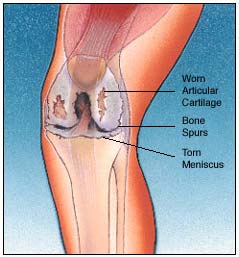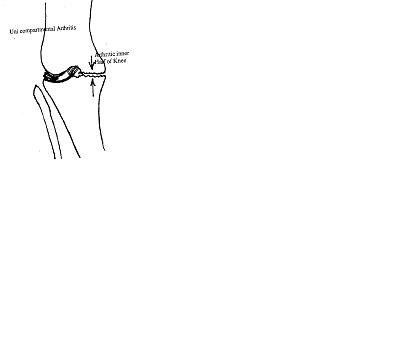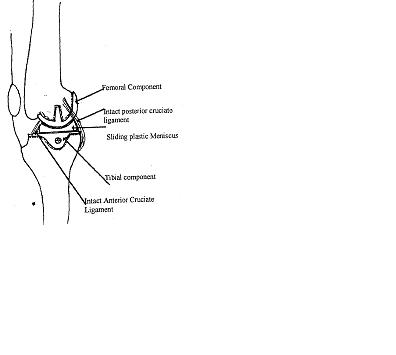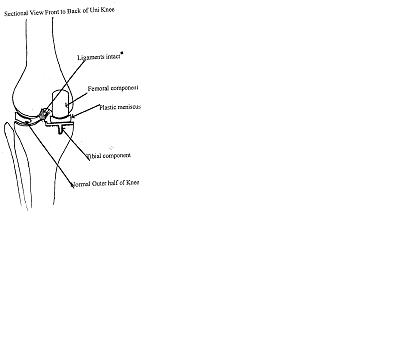|
UNICOMPARTMENTAL KNEE REPLACEMENT
A Guide for Patients
The Basford Consulting Rooms has a number of Orthopaedic Surgeons who specialise in Knee Replacement Surgery.
Introduction
Total joint replacement (arthroplasty) is a common and very successful surgery for people with degenerative arthritis (osteoarthritis) of the knee. If osteoarthritis damage to the knee meets certain qualifications, the consultant may recommend a unicompartmental knee arthroplasty (UKA). This can restore knee function and significantly diminish osteoarthritis pain in carefully selected patients.
The decision to have the operation is yours. Your decision must be based upon weighing the benefits against any risks. If you have any questions as you read through this leaflet then ask the doctor, nurse or therapist at your next visit. You may find it helpful to make a note of your questions before you see the Consultant or nurse.
Osteoarthritis of the Knee
 A normal knee glides smoothly because articular cartilage covers the ends of the bones that form joints. Osteoarthritis damages the cartilage, progressively wearing it away. The ends of the bones become rough like pieces of sandpaper. Damaged cartilage can cause the joint to "stick" or lock, and the knee may become painful and stiff and lose range of motion. A normal knee glides smoothly because articular cartilage covers the ends of the bones that form joints. Osteoarthritis damages the cartilage, progressively wearing it away. The ends of the bones become rough like pieces of sandpaper. Damaged cartilage can cause the joint to "stick" or lock, and the knee may become painful and stiff and lose range of motion. 
The recommendation of a surgical procedure for treating osteoarthritis of the knee depends
in part on how it is damaged. The knee has three joints (compartments), any or all of which
can be affected by osteoarthritis:
·
The inside (medial) compartment (medial tibial plateau and medial femoral condyle) is most
commonly involved, producing a bowleg (genu varum) deformity.
·
The outside (lateral) compartment (lateral tibial plateau and lateral femoral condyle) is
sometimes involved in women or obese people, producing a knock-knee (genu valgum) deformity.
The kneecap (patellofemoral) compartment (patella and femoral trochlear notch) may also develop osteoarthritis.
If you have early-stage arthritis confined to one part of the knee, a unicompartmental knee arthroplasty may be recommended. In addition, your ligaments must be in good condition and you should not be obese.
What is a Unicompartmental Knee Arthroplasty?
 Unicompartmental knee arthroplasty is a surgical procedure in which damaged parts of Unicompartmental knee arthroplasty is a surgical procedure in which damaged parts of
the knee joint are replaced with an artificial joint (prosthesis). During the procedure the
relevant worn out surfaces of the femur, tibia or patella are removed and replaced with
smooth artificial surfaces and a plastic insert between them. These artificial pieces are
attached to the bone with bone cement (methyl-methacrylate) or special coatings, which
encourage the bone to grow onto the prosthesis. Your Consultant will decide which type
is suitable for you.
An artificial knee is not as good as a normal knee, but by replacing your diseased knee joint
with an artificial joint, knee replacement surgery can relieve your pain and help you to get back
to enjoying normal, everyday activities again.
How successful is a Unicompartmental Knee Arthroplasty?
Results are normally very good. Almost all patients are relieved of their knee pain. As the pain lessens, function also improves. The results are comparable to Total Knee Replacement.
An artificial knee is not a normal knee and it will not allow you to return to active sports or heavy manual work. Activities must be avoided that overload the artificial knee. Most patients have an improved range of movements and limp less, but 5-10% of patients continue to have stiffness.
Comments
Unicompartmental Knee Arthroplasty
alleviates pain and may delay the need for total knee replacement. You get better joint motion and function because the procedure
preserves both cruciate ligaments and other healthy parts of the knee.
You also keep the bone stock in the kneecap joint and the other compartment, which can be helpful if you ever need conversion to total knee replacement in the future.
Complications are rare, but the new joint could develop an infection or slip out of place after surgery. For these reasons, your doctor may want to see you for follow-up visits after surgery.
You will have to do range of motion and other physical therapy exercises to rehabilitate your knee.
Less blood loss during surgery.
Recovery from Unicompartmental Knee Arthroplasty is faster than from total knee replacement or osteotomy.
Please read our booklet on Total Knee Replacements.
| 




